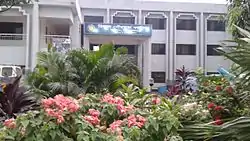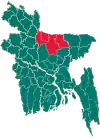Trishal Upazila
Trishal (Bengali: ত্রিশাল) is an upazila of Mymensingh District[1] in the Division of Mymensingh, Bangladesh. The famous Bengali poet Kazi Nazrul Islam attended a school here.
Trishal
ত্রিশাল | |
|---|---|
 View Of Trishal Municipality (pouroshobha) Vobon | |
 Trishal Location in Bangladesh | |
| Coordinates: 24°34.5′N 90°23.5′E | |
| Country | Bangladesh |
| Division | Mymensingh Division |
| District | Mymensingh District |
| Area | |
| • Total | 338.98 km2 (130.88 sq mi) |
| Population (2011) | |
| • Total | 419,308 |
| • Density | 1,200/km2 (3,200/sq mi) |
| Time zone | UTC+6 (BST) |
| Website | Official Map of Trishal |
Demographics
According to the 2011 Bangladesh census, Trishal had a population of 419,308. Males constituted 49.76% of the population and females 50.24%. Muslims formed 97.23% of the population, Hindus 2.70%, Christians 0.02% and others 0.05%. Trishal had a literacy rate of 40.02% for the population 7 years and above.[2]
At the 2001 Bangladesh Population Census ,Total Population 372,498; male 190,428, female 182,070; Muslim 361,731, Hindu 10,340, Buddhist 16, Christian 15 and others 396.
At the 1991 Bangladesh Population census, Trishal had a population of 336,797, of whom 158,390 were aged 18 or older. Male 171,664 Female 165,133. Males constituted 50.97% of the population, and females 49.03%. Trishal had an average literacy rate of 25.2% (7+ years), against the national average of 32.4%.[3] In 2001 Trisal has population of 372,498. Male 190,428 and Female 182,070. Household 79,941 and Literacy rate 40.2%.[3]
Administration
Trishal Upazila is divided into Trishal Municipality and 12 union parishads: Amirabari, Bailar, Baliparar, Dhanikhola, Harirampur, Kanihari, Kanthal, Mathbari, Mukshapur, Rampura, Sakhua, and Trishal. The union parishads are subdivided into 91 mauzas and 158 villages.[4]
Trishal Municipality is subdivided into 9 wards and 12 mahallas.[4]
Unions and villages
The following 12 Unions' list (Alphabetical Arranged) is given below:
- Trishal Union- Area 2827 hectares, Name of Village : Aultia Golaghita, Bagan, Chikna Monohar, Konabari, Naodhar, Panch Para, Satra Para, Salimpur, Trishal
- Amirabari Union- Area 2068 hectares, Name of Village : Amirabari, Baragaon (1st. Portion), Baragaon (2nd. Portion), Gopalpur, Guziam, Narayanpur and Amira bari (Namapara)
- Bailar Union- Area 2548 hectares, Name of Village : Bailar, Dewaniabari, Dulalbari, Hadderbhita, Kanhar, Kazir Simla, Pardhanikhola, Rudragram
- Baliparar Union- Area 3113 hectares, Name of Village : Amian Dangari, Bahadurpur, Bali Para, Beara, Char Madakhali, Char Madakhali Purbai, Dhala, Ichhamati, Kalsiddha, Kazigram, Patuli
- Dhanikhola Union- Area 3140 hectares, Name of Village : Dhanikhola,Sonakhali, Pajlarchar, Madhya Bhatipara, Uzan bhatipara, Charkumaria, Dakkhin Bhatipara, Samania Para, Bhawaliapara, Goysapara, jhiarpar, Palashtoli, Chopagaria,Moishateki, Katakhali,
- Harirampur Union- Area 2380 hectares, Name of Village : Nighor kanda, Chauladi, Golabhita, Harirampur, Magurjora, Rayer gram & South Kanda.
- Kanihari Union- Area 3120 hectares, Name of Village :Baraigaon, Bahalikanda, Polashtoly, Baghadaria, Baghadaria Dak, Balidia, Barma, Bearta, Chandbari, Deopara, Gobindapur, Garpara, Jilki, Kanihari, Kushtia (1), Kushtia(2), Mandatia, Raghab Bari, Sultanpur, Thapanhala, Tirkhi,
- Kanthal Union- Area 2364 hectares, Name of Village : Baniadhala, Banpathalia, Dhala Amian, Jasiddhar, Kanthal, Muhuriabari, Nalchira, Rajabari, Bangram, Singrail
- Mathbari Union- Area 3766 hectares, Name of Village : Alahari, Badamia, Kuragacha, Khagati Para, Horiyagoni, Mathabari
- Mukshapur Union- Area 2836 hectares, Name of Village : Kaitarbari, Konabakhai, Lalpur, Mukshapur, Nijbakhai, Phuti, Shankibhanga, Sapkhali,senerchak, jamtoli
- Rampura Union- Area 2827 hectares, Name of Village : Darila, Kakchar, Rampura
- Sakhua Union- Area 1752 hectares, Name of Village : Akhrail, Babupura, Bishnupur, Gandakhola, Nagarchhara, Naopara, Sakhua
Education
University
- Jatiya Kabi Kazi Nazrul Islam University, established on 1 March 2005. Its first batch class was started in June 2007.
Colleges
- Government Nazrul College
- Trishal Women's Degree College
- Trishal Women's Technical & B.M. College
- Islami Academy School & College
- Trishal Technical and B.M. College
- Aulianagar College
- Kalir Bazar School & College
- Danikhola Technical & Commercial College
- Mukshapur College
- Trishal International School & College
- Trishal Ideal School & College
- Kanthal High School & College
- Hazi Cherag Ali Degree College, Dhanikhola
Gallery
 Sutia River at Trishal
Sutia River at Trishal Sutia River at Dapuniya Bazar, Trishal
Sutia River at Dapuniya Bazar, Trishal Banar River at Kashiganj, Trishal
Banar River at Kashiganj, Trishal Trishal porosoba Office
Trishal porosoba Office Gate Of Government Nazrul College
Gate Of Government Nazrul College
Notable residents
- Abul Mansur Ahmed, journalist, politician and littérateur, was born at Dhanikhola in 1898.[5]
- Abul Kalam Shamsuddin, journalist and littérateur, was born at Trishal in 1897.[6]
References
- Shabbir Rifat (2012), "Trishal Upazila", in Sirajul Islam and Ahmed A. Jamal (ed.), Banglapedia: National Encyclopedia of Bangladesh (Second ed.), Asiatic Society of Bangladesh
- "Bangladesh Population and Housing Census 2011: Zila Report – Mymensingh" (PDF). Table P01 : Household and Population by Sex and Residence, Table P05 : Population by Religion, Age group and Residence, Table P09 : Literacy of Population 7 Years & Above by Religion, Sex and Residence. Bangladesh Bureau of Statistics (BBS), Ministry of Planning, Government of the People’s Republic of Bangladesh. Retrieved 14 December 2018.
- "Population Census Wing, BBS". Archived from the original on 27 March 2005. Retrieved 10 November 2006.
- "District Statistics 2011: Mymensingh" (PDF). Bangladesh Bureau of Statistics. Archived from the original (PDF) on 13 November 2014. Retrieved 14 July 2014.
- Razzaque, Rana (2012). "Ahmed, Abul Mansur". In Islam, Sirajul; Jamal, Ahmed A. (eds.). Banglapedia: National Encyclopedia of Bangladesh (Second ed.). Asiatic Society of Bangladesh.
- Islam, Shahidul (2012). "Shamsuddin, Abul Kalam". In Islam, Sirajul; Jamal, Ahmed A. (eds.). Banglapedia: National Encyclopedia of Bangladesh (Second ed.). Asiatic Society of Bangladesh.
